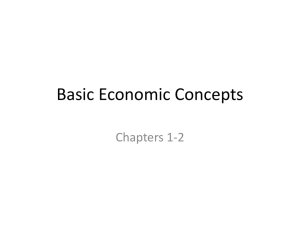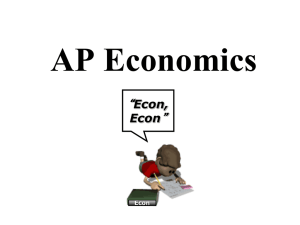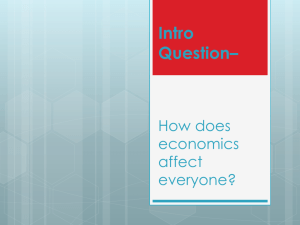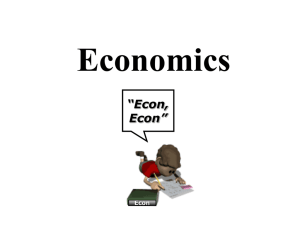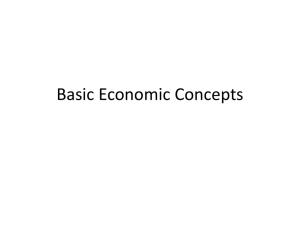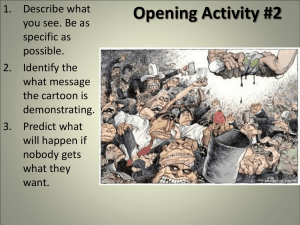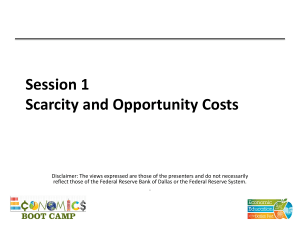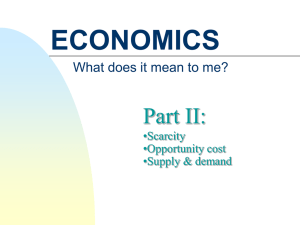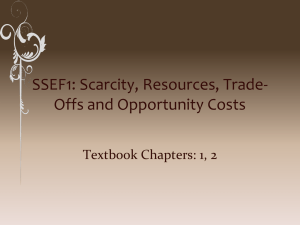Unit 1: Basic Economic Concepts
advertisement
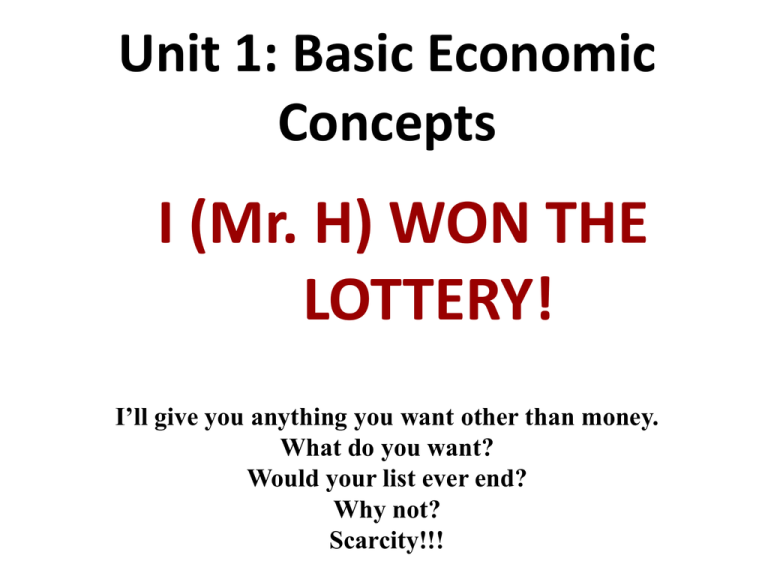
Unit 1: Basic Economic Concepts I (Mr. H) WON THE LOTTERY! I’ll give you anything you want other than money. What do you want? Would your list ever end? Why not? Scarcity!!! What is Economics? • Economics is the science of scarcity. • Scarcity means that we have unlimited wants but limited resources. • Since we are unable to have everything we desire, we must make choices on how we will use our resources. Economics is the study of _________. choices In economics we will study the choices of individuals, firms, and governments. Examples: You must choose between buying jeans or buying shoes. Businesses must choose how many people to hire Governments must choose how much to spend on welfare versus military. Textbook Definition Economics- Social science concerned with the efficient use of scarce resources to achieve maximum satisfaction of economic wants. (Study of how individuals and societies deal with ________) scarcity Scarcity Analyzing Choices Characteristics of Cost • Costs are to people. All costs are costs to the decision-maker. • Costs are subjective; individuals value costs differently. • Opportunity costs may change and changes in costs affect people’s choices. • Only actions have costs. “Things” have no costs independent of decisions about their use. • All costs lie in the future. The anticipation of future consequences shapes people’s decisions. Trade-offs and Opportunity Cost ALL decisions involve trade-offs. Trade-offs are all the alternatives that we give up whenever we choose one course of action over others.(Examples: going to the movies) The most desirable alternative given up as a result of a decision is known as opportunity cost. What are trade-offs of deciding to go to college? What is the opportunity cost of going to college? GEICO assumes you understand http://www.youtube.com/watch?v=91LQWQEyD8w&feature=related opportunity cost. Why? Given the following assumptions, make a rational choice in your own self-interest (hold everything else constant)… 1. You want to visit your friend for a week 2. You work every weekday earning $100 per day 3. You have three flights to choose from: Thursday Night Flight = $275 Friday Early Morning Flight = $300 Friday Night Flight = $325 Which flight should you choose? Why? Paul Solman: The Butcher, the Baker, and the Brewer What is meant by rational maximizing? Review with your neighbor… 1. Define scarcity 2. Define Economics 3. Identify the relationship between scarcity and choices 4. Define opportunity cost 5. Give an example of an opportunity cost you faced after you left school yesterday. Paul Solman Video: Opportunity Lost Micro vs. Macro MICROeconomicsStudy of small economic units such as individuals, firms, and industries (ex: supply and demand in specific markets, production costs, labor markets, etc.) MACROeconomicsStudy of the large economy as a whole or economic aggregates (ex: economic growth, government spending, inflation, unemployment, international trade etc.) Micro vs. Macro MICROeconomicsStudy of small economic units such as individuals, firms, and industries (ex: supply and demand in specific markets, production costs, labor markets, etc.) MACROeconomicsStudy of the large economy as a whole or economic aggregates (ex: economic growth, government spending, inflation, unemployment, international trade etc.) 5 Key Economic Assumptions 1. Society’s wants are unlimited, but ALL resources are limited (scarcity). 2. Due to scarcity, choices must be made. Every choice has a cost (a trade-off). 3. Everyone’s goal is to make choices that maximize their satisfaction. Everyone acts in their own “selfinterest.” 4. Everyone makes decisions by comparing the marginal costs and marginal benefits of every choice. 5. Real-life situations can be explained and analyzed through simplified models and graphs. Thinking at the Margin # Times Watching Movie Benefit Cost 1st 2nd 3rd Total $30 $15 $5 $50 $10 $10 $10 $30 Would you see the movie three times? Notice that the total benefit is more than the total cost but you would NOT watch the movie the 3rd time. Marginal Analysis In economics the term marginal = additional “Thinking on the margin”, or MARGINAL ANALYSIS involves making decisions based on the additional benefit vs. the additional cost. For Example: You have been shopping at the mall for a half hour, the additional benefit of shopping for an additional half-hour might outweigh the additional cost (the opportunity cost). After three hours, the additional benefit from staying an additional half-hour would likely be less than the additional cost. Marginal Analysis Notice that the decision making process wasn’t “should I go to the mall for 3 hours or should I stay home” In reality the decision making process started with “should I go to the mall at all.” Once you are there you thought “should I stay for an additional half hour or should I go.” The MARGINAL ANALYSIS approach to decision making is more commonly used than the “all or nothing” approach. Marginal Analysis Notice that the decision making process wasn’t “should I go to the mall for 3 hours or should I stay home” You will continue to do something until the In reality the decision making process started marginal cost with “shouldoutweighs I go to the the mallmarginal at all.” Once you are there you thought “should I stay benefit. for an additional half hour or should I go.” The MARGINAL ANALYSIS approach to decision making is more comely used than the “all or nothing” approach.
